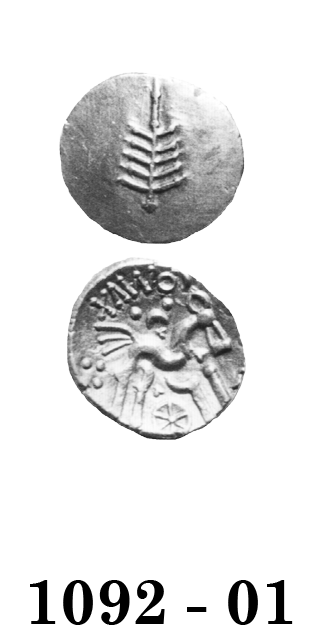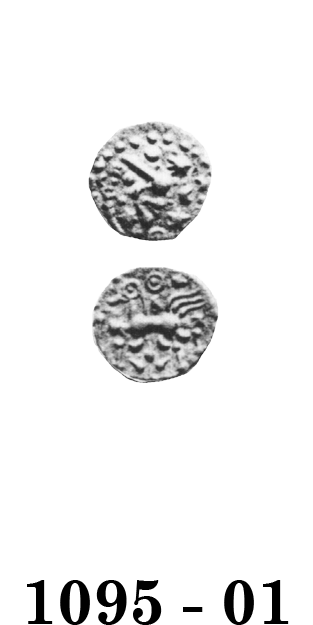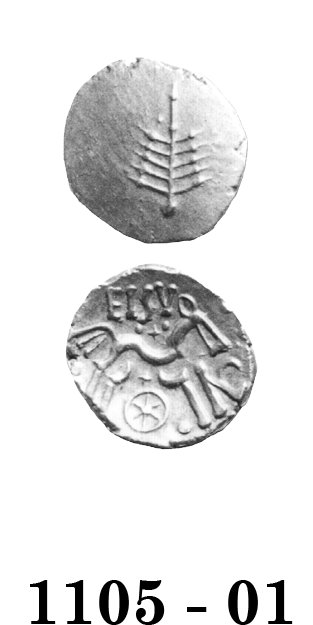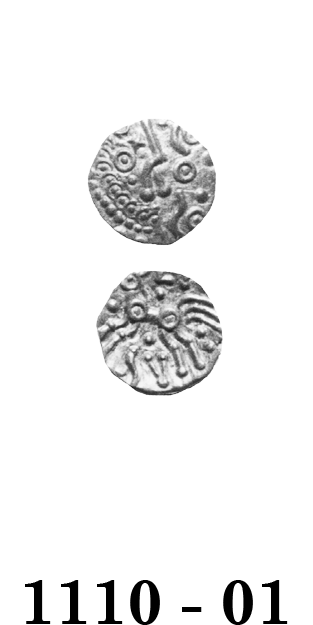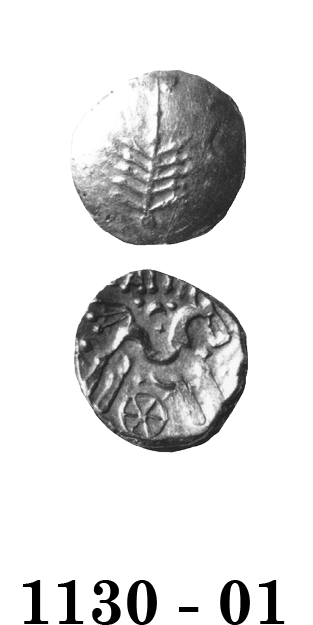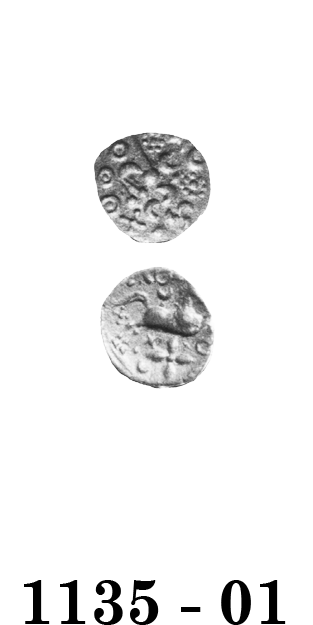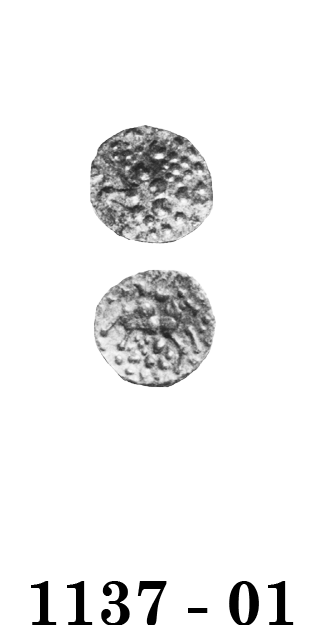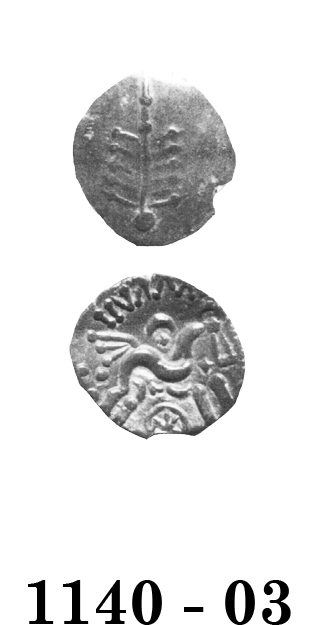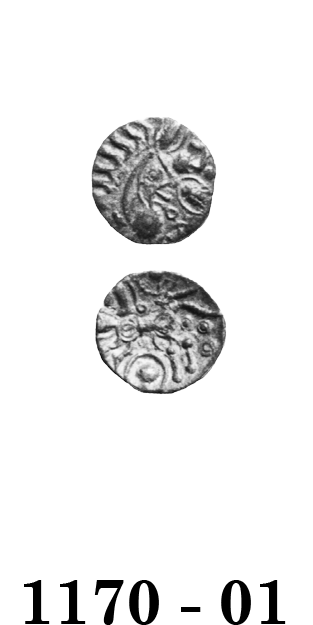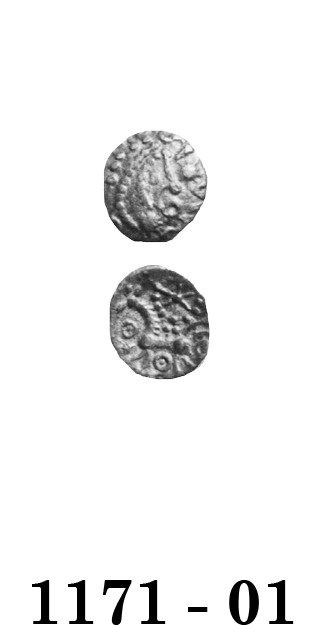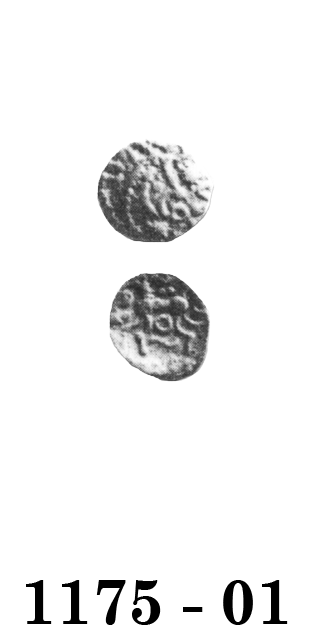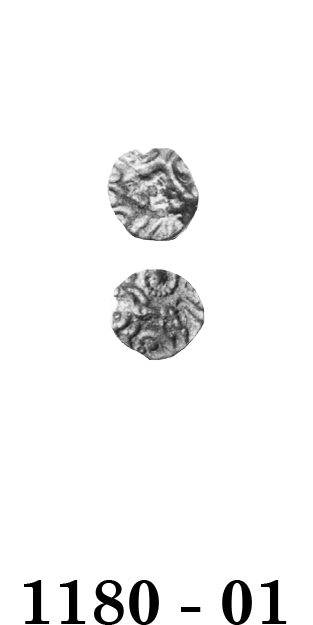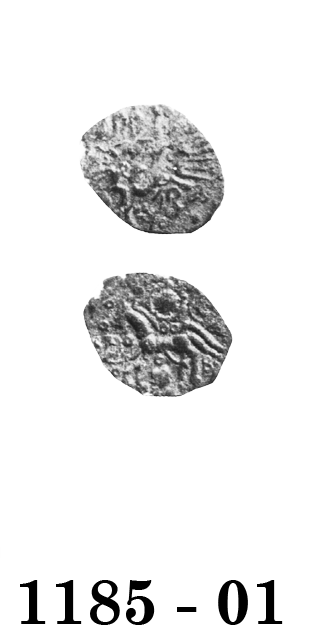
Celtic Coinage of Britain
third edition
Click on coin to see hidden information
Dobunnic Irregular Coinage
Four unusual types of silver coins have been identified by Allen as an irregular Dobunnic coinage. There are many die varieties and fractional denominations may exist. The five coins listed here are representative of the series. A sixth type, more like the regular series in style, has been reassigned and listed under COMUX, number 1095 - 01 (see this Plate).
Though unlikely, the series might represent a "Sub-Dobunnic" coinage, that of a separate tribal group centred in Wiltshire. The suggestion of a "Sub-Dobunnic" coinage now appears to have been an over-interpretation of insufficient data. When only a few coins were known, most had been found on the eastern fringe of Dobunnic territory. Recent finds have occurred in other parts of Dobunnic territory, however, and today it is difficult to prove a "Sub-Dobunnic" coinage actually existed. In any event, the coins listed below are unusual and probably represent local issues of some sort, not necessarily those of a separate tribal group.
The chronology of the series is problematic, but stylistically it appears to come after Dobunnic B and before Dobunnic G, thus dating between 15 B.C. and 30 A.D. The attribution and dating of the Irregular Series is unsatisfactory and represents an opportunity for original research.
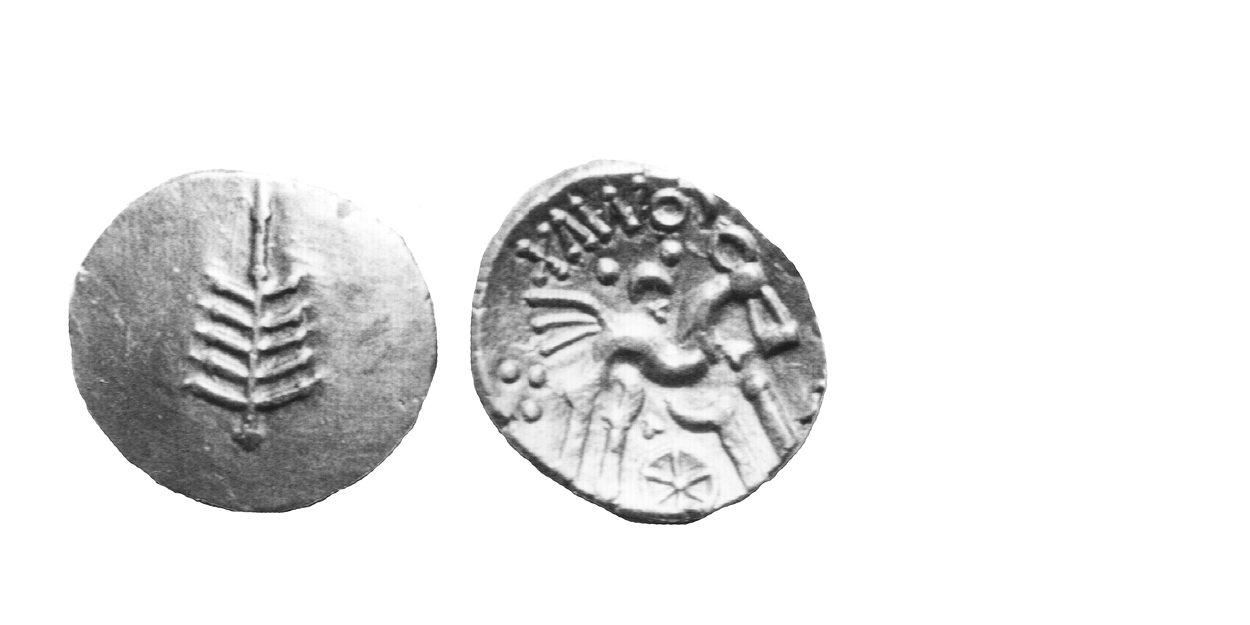
1092 - 01 Comux
10–15 A.D. Extremely Rare
Gold Stater 5.45 gms. 19 mm
Earliest Record: Evans, 1864
OBV: Dobunnic Emblem
Identifying points:
- Emblem made up of tree-like object with ten branches
REV: Celticized horse right
Identifying points:
- tail has three strands with pellets
- elliptical ear
- COMUX up-side-down above horse
- three pellets below tail
- six-spoked wheel below horse
CLASSIFICATION: Dobunnic E
NOTES:
- Stamdard Weight given
- Some in museums
- Modern forgery exists – (see 1092 - 01F)
- COMUX is a variant spelling of the Celtic name Commius
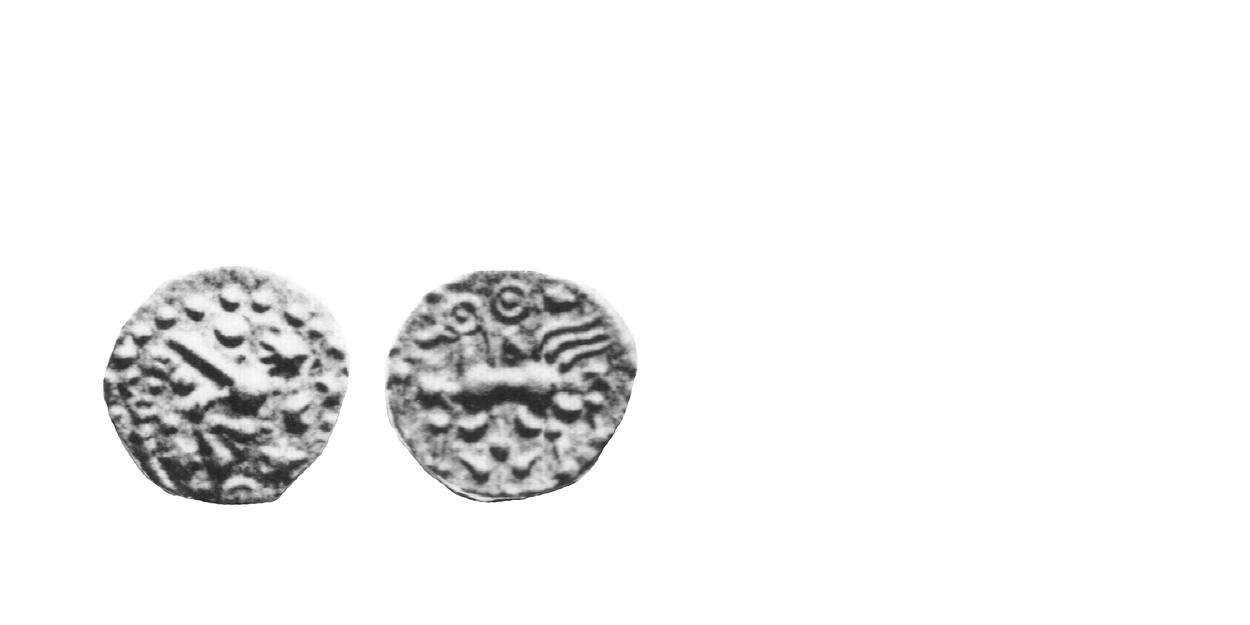
1095 - 01 Comux Head Type
10-15 A.D. Extremely Rare
Silver Unit ca. 1.15 gms. 14 mm
Earliest Record: Allen, 1961 (found Worcester, 1958)
OBV: Celticized head right
Identifying points:
- head more stylized than on 1082 - 01
- O-X-O pattern on Class F is here replaced with a six-pointed star
- six-pointed star near nose
- five-pointed star near mouth
- pellet in ring motif below mouth
REV: Celticized horse left
Identifying points:
- triple stranded tail
- flower below horse
- five-pointed star below tail
- pellet in ring motif and crescent above tail
CLASSIFICATIONON: Dobunnic E
NOTES:
- Typical weight given, Standard Weight is not yet identified
- Most in museums
- This type was traditionally considered part of the Dobunnic Irregular Series, however horse has triple tail and flower below
- Typologically it is similar to Classes I and J, assigned to CATTI
- This coin has been assigned to COMUX arbitrarily but may belong to another ruler
- Allen Class MX
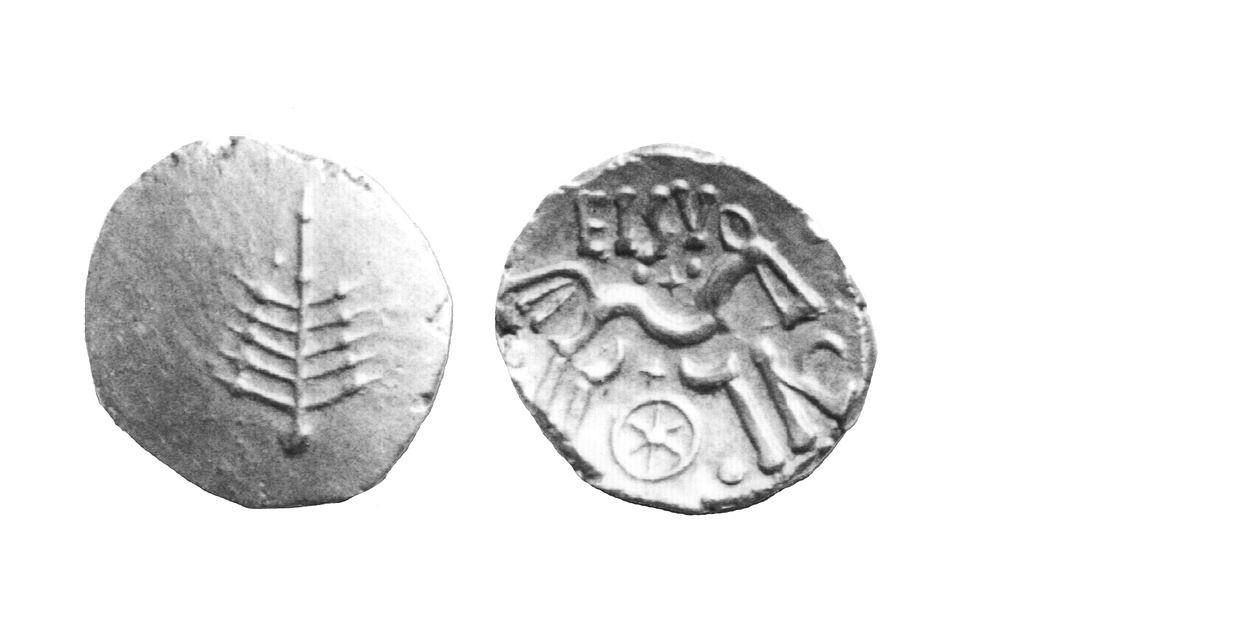
1105 - 01 Eisv
15-30 A.D. Rare
Gold Stater 5.40 gms. 19 mm
Earliest Record: Camden 1610
OBV: Dobunnic Emblem
Identifying points:
- emblem made up of tree-like object with ten branches
REV: Celticized horse right
Identifying points:
- tail has three strands with pellets
- elliptical ear
- six-spoked wheel below horse
- hook-like object in front of horse
- three pellets below tail
- EISV above horse
CLASSIFICATION: Dobunnic F
NOTES:
- Standard Weight given
- Some in museums
- Hook-like object in front of horse may be vestigial letter from "R" in RIG on staters of ANTEDRIG
- Modern forgery exists – (see 1105 - 01F)
- EISV Quarter staters are all modern forgeries – (see FANTASY 9)
- Camden also suggested the obverse was an "ear of corne" (Camden 1610, p. 99)
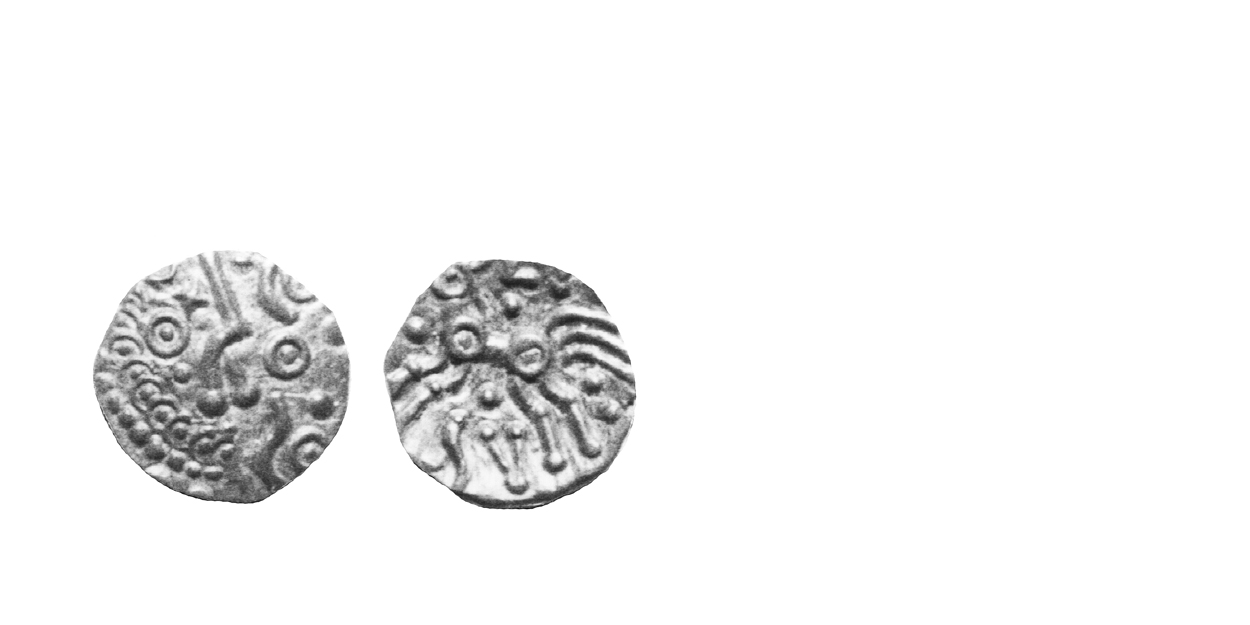
1110 - 01 Eisv Head Type
15-30 A.D. Common
Silver Unit ca. 1.15 gms. 13 mm
Earliest Record: Allen, 1864
OBV: Celticized head right
Identifying points:
- similar to 1082 - 01
- O-X-O pattern on face made up of two pellet in ring motifs with "X" in between
- four pellet in ring motifs in front of face
REV: Celticized horse left
Identifying points:
- triple stranded tail
- pellet in ring motif in front of horse
- El above horse
- SV below horse
- three pellets below tail
CLASSIFICATION: Dobunnic F
NOTES:
- Typical weight given, Standard Weight is not yet identified
- Allen designated this type Class H
- Celtic Coin Index now indicates commoner than previously thought
- Some in museums
- Modern forgery exists – (see 1110 - 01F)
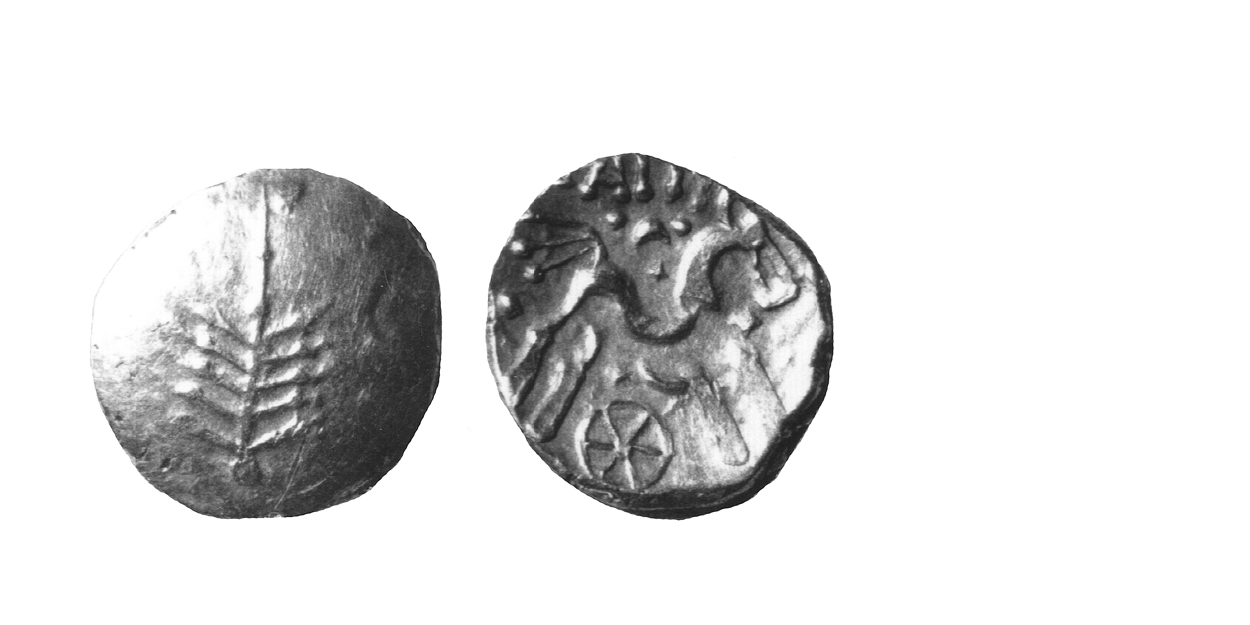
1130 - 01 Catti
30-43 A.D. Rare
Gold Stater 5.35 gms. 18 mm
Earliest Records: Akerman, 1837b, Ruding, 1840, Hawkins, 1841, Poste, 1853
OBV: Dobunnic Emblem
Identifying points:
- emblem made up of tree-like object with ten branches
- one obverse die shows successive damage at two o'clock in form of a triangular depression in field of coin
REV: Celticized horse right
Identifying points:
- tail has three strands with pellets
- six-spoked wheel below horse
- three pellets below tail
- CATTI above horse
CLASSIFICATION: Dobunnic G
NOTES:
- Standard Weight given
- Celtic Coin Index now indicates commoner than previously ghought
- Some in museums
- Modern forgery exists – (see 1130 - 01F)
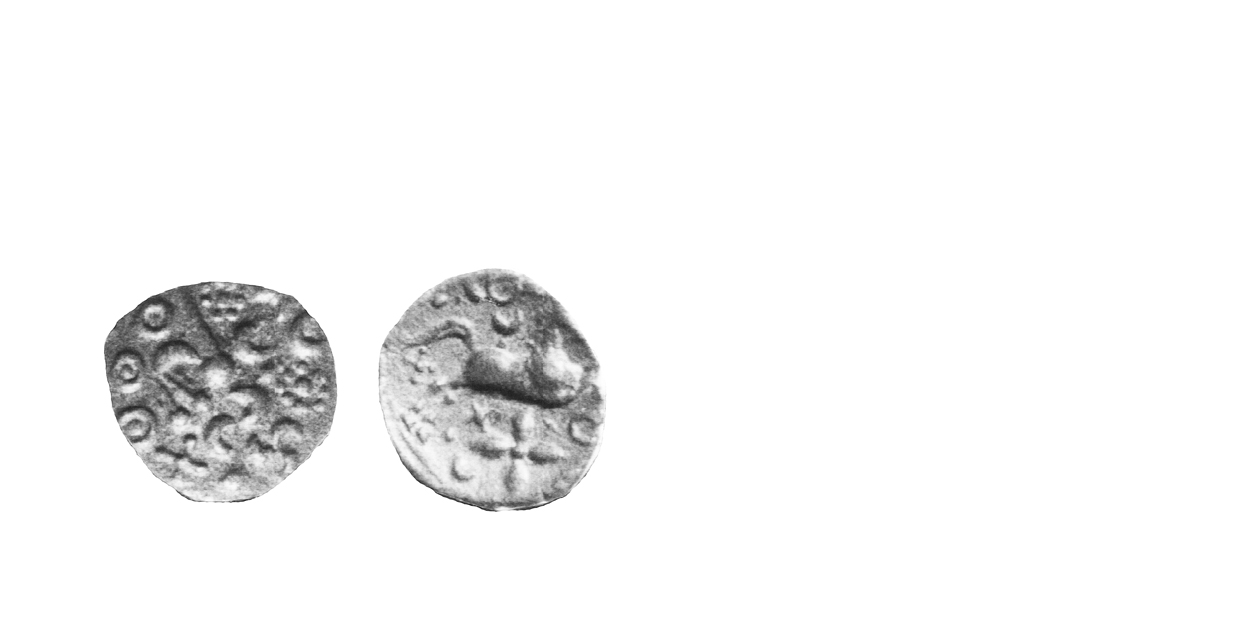
1135 - 01 Catti Head Type
30-43 A.D. Scarce
Silver Unit ca. 1.15 gms. 13 mm
Earliest Record: Evans, 1864
OBV: Celticized head right
Identifying points:
- very stylized head
- cross with pellet-ends below head
- daisy and ring at top of face
- two daisies in front of face
REV: Celticized horse left
Identifying points:
- horse more naturalistic
- single strand tail
- cross with pellet ends below tail
- large cross below horse with small cross in upper left angle and pellets in other angles
- ring with three crescents above horse
CLASSIFICATION: Dobunnic G
NOTES:
- Typical weight given, Standard Weight is not yet identified
- Celtic Coin Index now indicates commoner than previously thought
- Some in museums
- Allen Class I
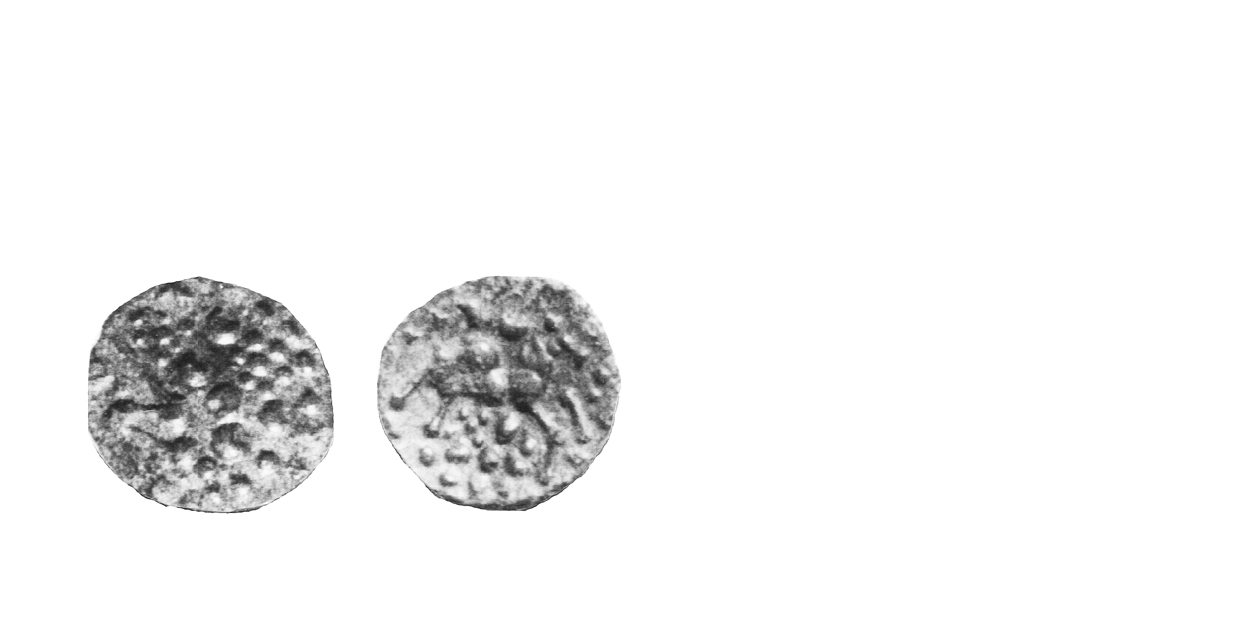
1137 - 01 Catti Head Type
30-43 A.D. Scarce
Silver Unit ca. 1.15 gms. 13 mm
Earliest Record: Mack, 1953
OBV: Celticized head right
Identifying points:
- extremely stylized head
- field in front of head filled with crescents, pellets and daisies
- cross with pellet-ends near mouth
REV: Celticized horse left
Identifying points:
- naturalistic horse
- tail has single strand
- "V" form below tail
- large cross-like flower below horse, with small cross in upper left angle and pellets in other angles
- ring with three crescents above horse
CLASSIFICATION: Dobunnic G
NOTES:
- Typical weight given, Standard Weight is not yet identified
- Celtic Coin Index now indicates commoner than previously thought
- Many in museums
- Allen Class J
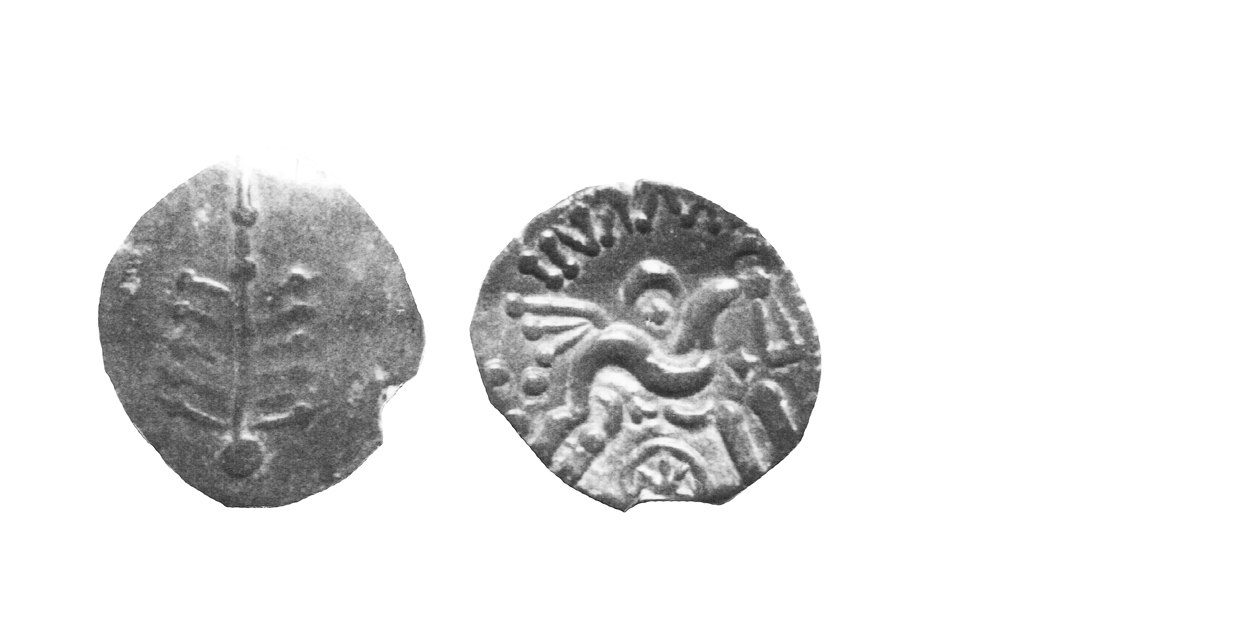
1140 - 03 Inam
43-45 A.D. Extremely rare
Gold/Bronze Plated Stater 4.12 gms. 18 mm
Earliest Record: Evans, 1864
OBV: Dobunnic Emblem
Identifying points:
- emblem blundered, has five branches on left, six on right
REV: Celticized horse right
Identifying points:
- tail has three strands with pellets
- three large pellets below tail
- wheel with probably six spokes below horse
- blundered legend above horse, reads INAM probably, or INARA less likely
CLASSIFICATION: Dobunnic H
NOTES:
- Weight given of the one recorded example
- Probably an ancient forgery
- Type from official mint may not exist, catalogue number 1140 - 01 reserved for a normal stater, if one is found
- Recorded example in BM
- Modern forgery exists of the normal stater – (see 1140 - 01F)
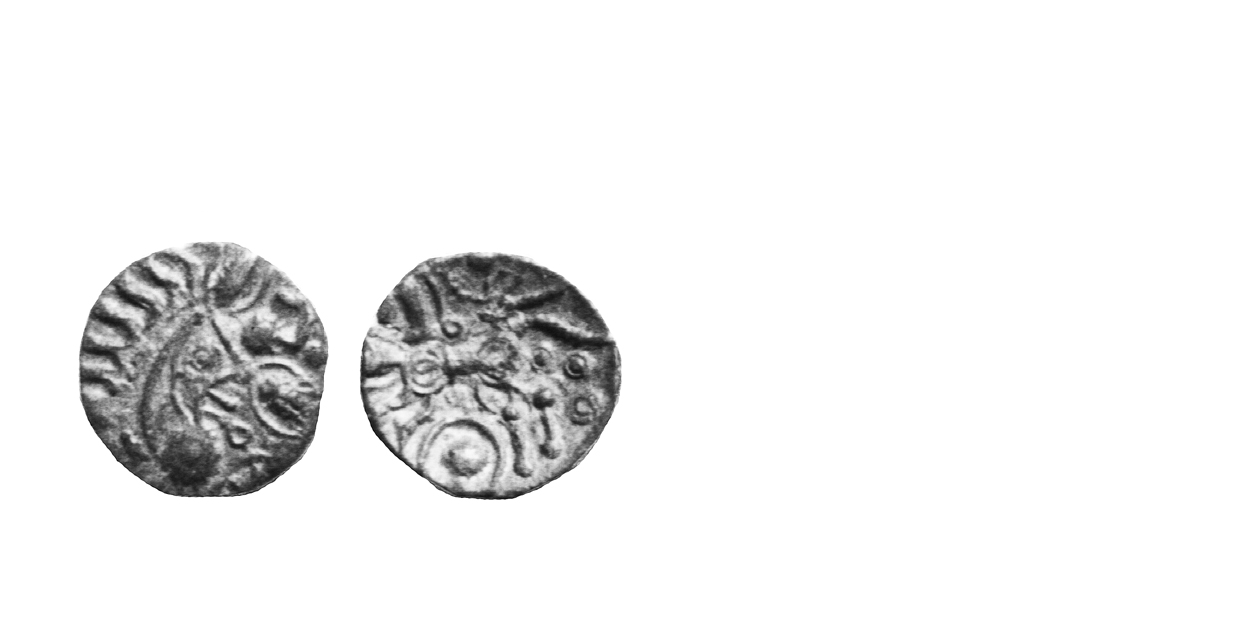
1170 - 01 Irregular Series
15 B.C.-30 A.D. Very rare
Silver Unit ca. 1.10 gm. 13 mm
Earliest Record: Evans, 1890
OBV: Celticized head right
Identifying points:
- sunburst on chin
- wavy lines for hair
- pellet in ring motif for eye
- two coffee beans in front of face
- sunburst near nose
REV: Celticized horse left
Identifying points:
- large pellet in ring under horse
- tail has two strands
- sunflower in ring of pellets above horse
CLASSIFICATION: None
NOTES:
- Typical weight given, Standard Weight is not yet identified
- Celtic Coin Index now indicates commoner than previously thought
- Most are in museums
- Obverse possibly derived from an Atrebatic coin – (see 282 - 01)
- Allen Class L
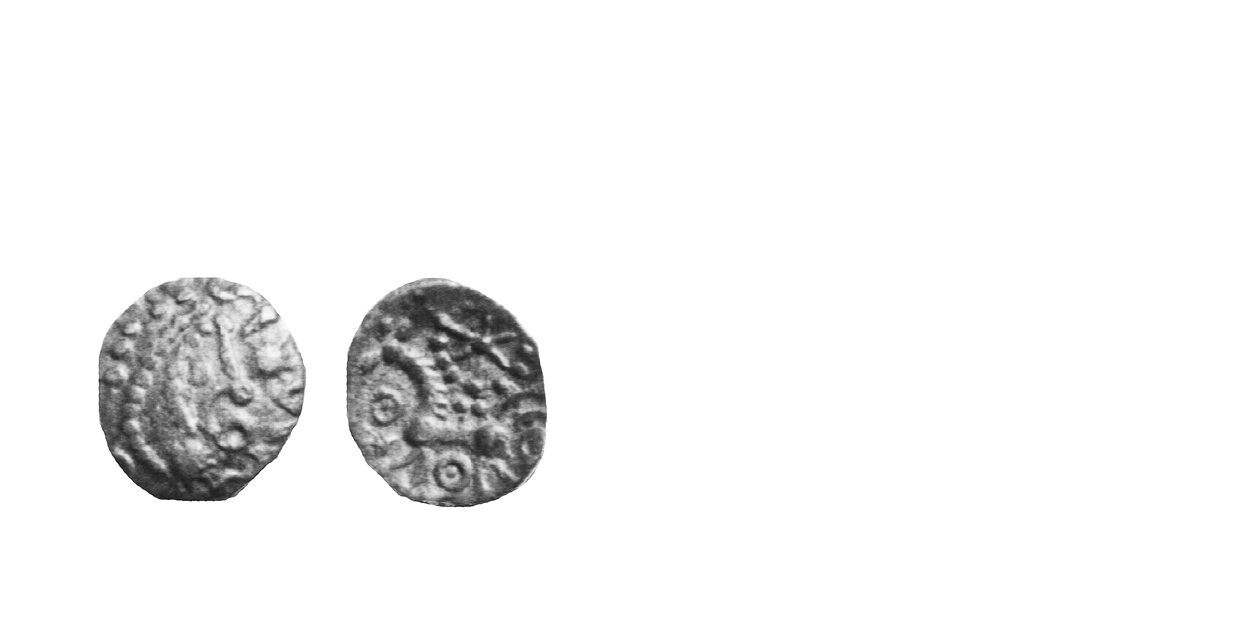
1171 - 01 Irregular Series
15 B.C.-30 A.D Extremely rare
Silver Unit 0.90-1.10 gms. 12 mm
Earliest Record: Van Arsdell, 1989
OBV: Celticized head right
Identifying points:
- similar to 1170 - 01, but has a pellet for the eye
REV: Celticized horse left
Identifying points:
- similar to 1170 - 01, but has a six-spoked wheel above the horse
CLASSIFICATION: None
NOTES:
- Typical weight given, Standard Weight is not yet identified
- Most are in museums
- Allen Class M
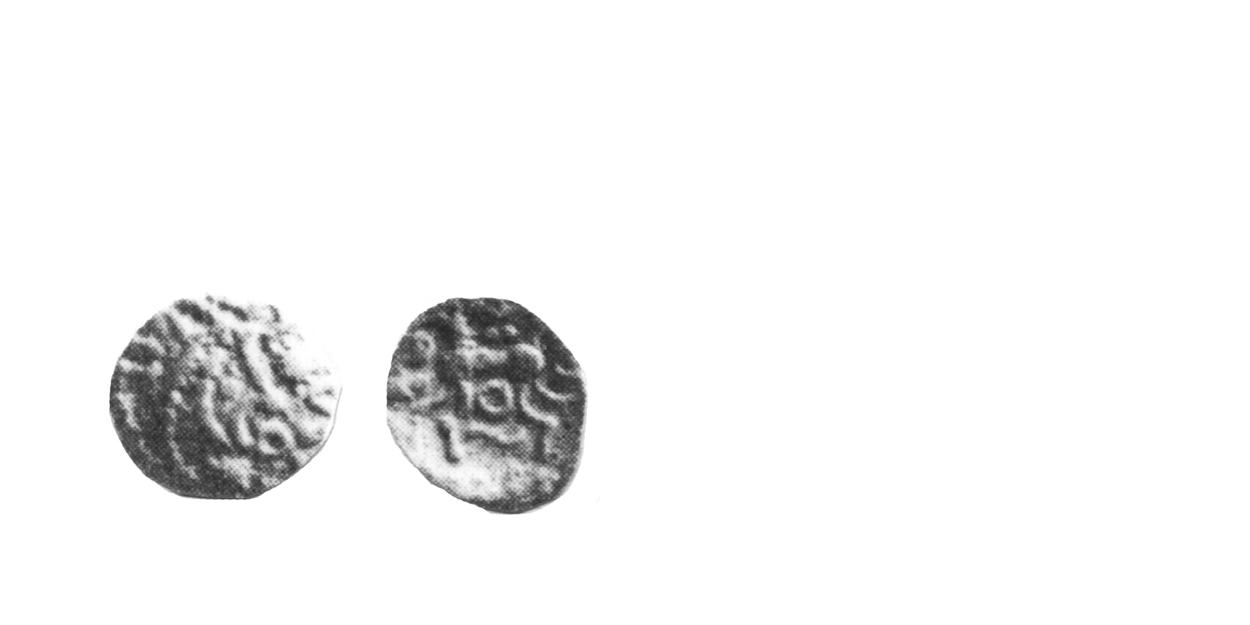
1175 - 01 Irregular Series
15 B.C.- 30 A.D. Rare
Silver Unit 0.9-1.10 gms. 12 mm
Earliest Record: Evans, 1890
OBV: Celticized head right
Identifying points:
- similar to 1170 - 01
- coffee beans missing
- hair made up of smaller lines
REV: Celticized horse left
Identifying points:
- pellet in ring motif below, behind and in front of horse
- tail has two strands
- large wheel made up of six spokes with pellet-ring above horse
CLASSIFICATION: None
NOTES:
- Typical weight range given, Standard Weight is not yet identified
- Some are in museums
- Celtic Coin Index now indicates commoner than previously thought
- Allen Class M
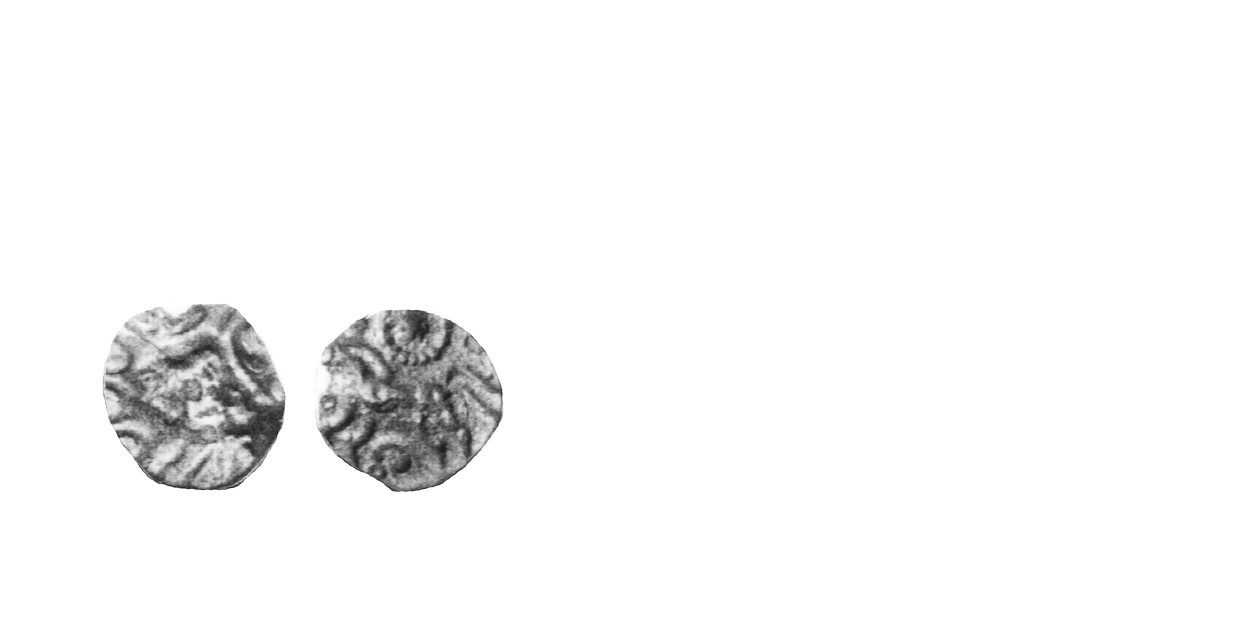
1180 - 01 Irregular Series
15 B.C.-30 A.D. Extremely Rare
Silver Unit 0.3-1.0 gm 11 mm
Earliest Record: Allen, 1961
OBV: Abstract Design
Identifying points:
- two large curves
- smaller crescents and curves
REV: Celticized horse left
Identifying points:
- tail has two strands
- pellet in ring motifs below and behind horse
- pellet in ring motif surrounded by pellet ring above horse
- horse's neck made up of two lines
CLASSIFICATION: None
NOTES:
- Typical weight range given, Standard Weight is not known
- Fractional denominations may exist
- Allen Class N
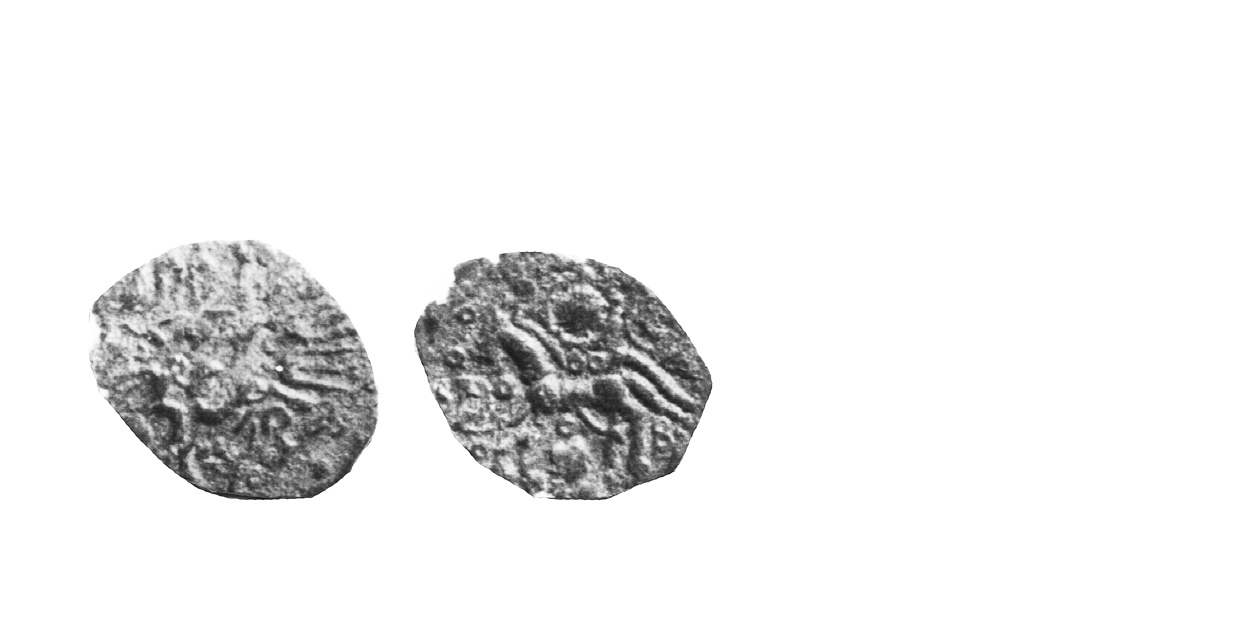
1185 - 01 Irregular Series
15 B.C.-30 A.D. Extremely Rare
Silver Unit ca. 0.6 gms. 16 mm
Earliest Record: Evans, 1890
OBV: Abstract Design
Identifying points:
- two lines of pellets in centre
- large curve intersects pellet-line
- other curves, lines and ellipses in field
REV: Celticized horse left
Identifying points:
- tail has two strands
- small crescent in front of horse
- large pellet below horse
- large pellet in ring motif above horse
CLASSIFICATION: None
NOTES:
- Typical weight given , Standard Weight is not yet identified
- Most are in museums
- Allen Class O
The Coinage of the Dobunni
The Dobunni occupied Gloucestershire and Avon, parts of Hereford and Worcestershire, Somerset, Oxfordshire and Wiltshire. Their coinage comprises a small number of gold coins, mostly inscribed, and an extensive series of silver units, largely without inscriptions.
The gold staters are almost identical in appearance, making it difficult to organize and date them. The following catalogue lists them in order according to their weight and metallic content. The Dobunni gradually reduced the weight and gold content of the staters, and this reveals the chronological sequence. This dating sequence was first proposed in the 1989 edition of Celtic Coinage of Britain.
An analysis of the intrinsic value of the staters gives the chronological order of the inscriptions. This is, in order of decreasing standard weight and gold content: CORIO, BODVOC, ANTEDRIG, COMUX, EISV and CATTI. CORIO and BODVOC's staters contain a standard 2.6 grammes of fine gold. This drops to 2.3 grammes for ANTEDRIG and COMUX, and finally to 2.2 grammes for EISV and CATTI. Metrologically and metallurgically, the Dobunnic coinage suffered the same debasement as the coins of the other British tribes. It seems, the Dobunni were under the same pressures to devalue their coinage.
The silver coins are related to the gold issues by the objects in the fields. Those near the horse's tail seem to give the best indicators as to ruler-of-origin m many cases. Three types are inscribed and carry the names BODVOC, ANTED and EISV. The units inscribed ANTED and EISV are accompanied by uninscribed coins of a similar type.
Three clues provide fixed points to construct an absolute chronology for the coinage, as a whole. First, the silver units of BODVOC typologically date to the end of the First Century B.C. The horse on the reverse is a mirror-image of one on a quarter stater of Tasciovanus-—the die cutters may have simply copied it directly onto their dies. Similarly, a Tasciovanus bronze may supply the prototype for the obverse, again in mirror-image. Previously, workers have dated BODVOC's coinage last because of the legend on the stater. The lettering need not be dated mid-First Century A.D., because similar letters do appear on earlier coins. Generally, BODVOC's coinage should be dated about the end of Tasciovanus' reign.
The second clue is the dramatic reduction in the gold content for ANTEDRIG, probably a reaction to the events of the Trinovantian/Catuvellaunian Interregnum. When the other tribes reduced the intrinsic value of their staters, the Dobunni reacted by debasing the gold content.
Finally, the Dobunnic coinage would have come to an end during the middle of the 40's A.D., as the Romans overran the Dobunnic territory. The plated stater with the blundered legend "INAM"' probably dates from this disturbed time.
Using the chronology of the gold staters, the following interpretation of the Dobunnic coinage is suggested. During the Gallic War, contacts with the Dobunni were organized by the Atrebates/Regni to obtain war materiel, perhaps iron, for the Continental trade. Atrebatic Abstract Type staters are found in Dobunnic territory attesting to the trade. After the war, the tribe eventually felt the need to produce its own coins, and uninscribed gold and silver pieces were first struck about 35 B.C.
The Atrebates/Regni and Trinovantes/Catuvellauni were already striking inscribed coins by this time. The Dobunni quickly followed their lead, adding the name CORIO to their staters, around 30 B.C. Later, at the end of Tasciovanus' reign, BODVOC succeeded CORIO. He removed the Dobunnic emblem from the staters and emblazoned his name across the field. He also changed the silver coins as well, by placing a more life-like head on the obverses.
BODVOC soon disappeared during the Trinovantian/Catuvellaunian Interregnum, replaced by ANTEDRIG. The Dobunnic emblem was immediately restored to the staters and it was maintained by all subsequent rulers. Possibly, BODVOC's removal of the emblem had been an unpopular change. A series of inscriptions occurs after ANTEDRIG, COMUX, EISV, and CATTI – leading up to the Claudian invasion, when the coinage ends.
This chronological sequence, derived from metallurgy and metrology, is unlike that proposed by earlier scholars. Consequently, it must be viewed as a hypothesis, not proven fact. Normally in a catalogue such as this, the traditionally accepted chronologies would be used, but those proposed by Allen over twenty-five years ago are clearly unworkable today. Because the chronological interpretation here is greatly different from Allen's, the reasons for the change should be discussed.
There are two problems with Allen's interpretations. The first is the order of the inscriptions – it requires the staters to increase in intrinsic value. This is unlikely because the neighbouring tribes were reducing the value of their coins. Secondly, there is inadequate pairing of the silver units with the gold staters. The tribe used silver coins extensively and probably there were silver coins corresponding to each of the gold types.
Hoard analysis has supplied the dating evidence for many tribal coinages, the best example is the relative dating of the Icenian silver. Unfortunately, the small number of Dobunnic hoards has hampered study here since most Dobunnic coins have been single finds. Two hoards contained coins of ANTEDRIG, EISV and CATTI, and one of them had uninscribed silver as well. This does not provide much information to construct a relative chronology.
A historical retrospective points out some additional areas of controversy. Evans, in 1864, identified the BODVOC staters as heavier than the rest and accordingly dated them earliest. Evans' argument – heavier coins are earlier – should not be taken so lightly. Additional coins have come to light since Evans wrote, so the BODVOC staters are no longer the heaviest.
The Interregnum dating for ANTEDRlG's coinage places him roughly at the time of ANTED of the Iceni. Evans' assertion – the coinages of ANTEDRIG and the Icenian ANTED represented the unified output of a single ruler – should be reconsidered.
Brooke, in 1933, gave a list with ANTEDRIG first and BODVOC last, but offered no explanation, leaving it to Allen to supply the missing interpretation. The coins seemed to have different findspot distributions, Allen noted, offering this as evidence for paired rulers in sequence: ANTEDRIG/EISV first and CORIO/BODVOC last. The inscribed silver coins of ANTEDRIG and EISV were almost identical to some stylistically late uninscribed types, but BODVOC's inscriptions looked Roman. Thus, Allen argued, ANTEDRIG and EISV must be first, BODVOC last. He placed CATTI and COMUX in between these, unpaired.
The argument for paired rulers is tenuous today; additional findspots have been added to the maps and the distributions now show no statistically valid differences. This is particularly true for CORIO and BODVOC, the two rulers whose coinages previously had shown a good example of mutual exclusivity.
A final problem is posed by a small number of uninscribed silver coins, described by Allen as the IRREGULAR SERIES. These have an unusual style that does not fit in well with the rest of the Dobunnic silver. Previously, the coins had been found only in Wiltshire, and a separate tribal group had been suggested as its source. Today, while still unusual, the coins cannot be seen as coming solely from Wiltshire, because recent finds have come from Gloucestershire. The distribution may ultimately be similar to the rest of the Dobunnic coinage. The irregular series may indeed be local issues, but there is no strong evidence they come from a separate tribe or sub group.
The arrangement of the catalogue is as follows: The early uninscribed coins are listed first. The Dobunni evidently used Atrebatic/Regnan coins after the Gallic War, striking their own for the first time around 35 B.C. Then the series of inscribed coins is given, using the order suggested by the metrology and metallurgy. The later uninscribed silver types are listed under the most likely ruler, based on stylistic similarities.
Allen's system of naming the silver coins by classes has been retained for the type nomenclature because it is still a useful guide to the typology. New classifications have been given, however, linking the gold and silver issues.
The site of a Dobunnic mint has been found at Bagendon, a large oppidum near Cirencester. Clay "coin-moulds", two pairs of tongs, a bronze ladle and a clay spoon for handling molten metal were found on the site during archaeological excavations. Several bronze lumps were found, which appeared to be the remains of coin dies. Of interest was a number of plated forgeries of Dobunnic coins found in the vicinity. The mint could have been turning out plated coins, or alternatively the finds represent coins taken to the mint for authentication, only to be discarded when the forgery was exposed by the mint workers.

